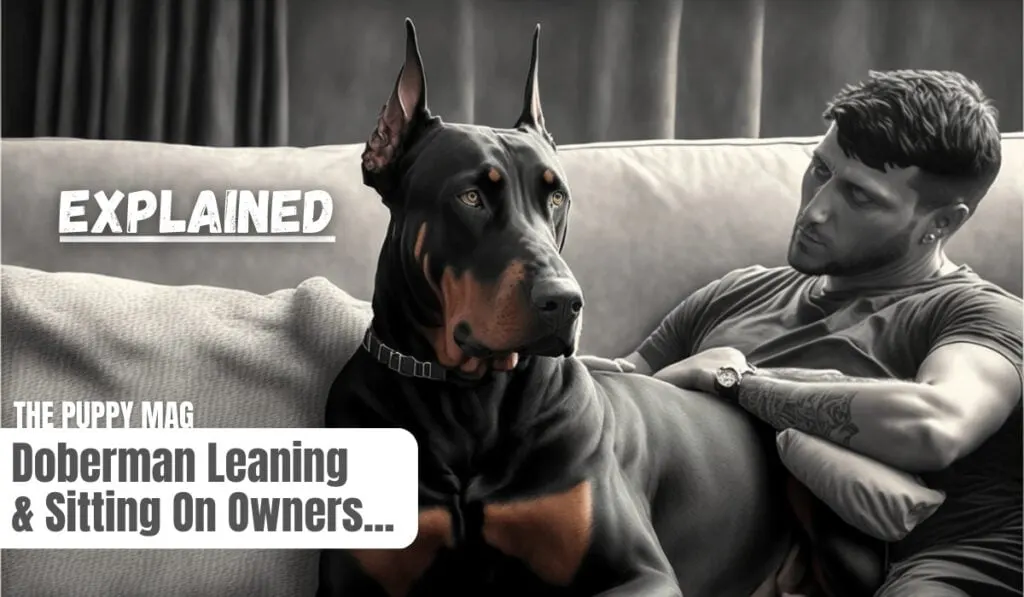Ever wondered what causes your Doberman to sit on you, lean on you, or place a paw on you?
This article explains the interesting reasons behind each of these intimate behaviors. Is it just affection, or is it something more?
Why Does My Doberman Lean On Me?

There are a few possible reasons why your Doberman might lean on you. One possibility is that they are seeking attention and affection from you.
Dogs lean on their owners as a way of getting closer to them and feeling more connected. They might also lean on you as a way of seeking comfort or feeling more secure.
Another possibility is that your Doberman is leaning on you because they feel anxious or stressed. Dogs will often lean on their owners as a way of seeking reassurance and comfort when they are feeling anxious or unsure.
Finally, your Doberman may be simply leaning on you because it’s comfortable for them. Dobes often lean on their owners when they are relaxing and taking a break, just as people might lean on a wall or chair when they are resting.
Why Does My Doberman Sit On Me?
Just like with leaning, sitting on you could signify that your Dobie is showing or trying to receive affection. In some cases, they may be trying to assert dominance.
Deliberate and obvious physical contact like this is a powerful body language act and signifies strong emotions, attachment, or feelings.
- And yes, it’s also possible that your Doberman is trying to sit on you as a way of asserting dominance.
Dogs will sometimes try to sit on top of their owners as a way of showing that they are the alpha in the relationship. This is more common in dogs that have not been properly trained and socialized, and it can be a sign of behavior problems.
Related: 10 Signs Your Doberman Loves You
Why Does My Doberman Rest a Paw On Me?
If your Doberman comes and rests just a paw on you, then it’s typically to show you affection or to feel close to you.
In some cases, this can also be considered a subtle sign of dominant behavior. Resting a paw physically on top of your leg or hand means they’re the one in charge.
Is Your Doberman Showing Affection or Asserting Dominance?
Many of these non-verbal gestures, like sitting on you or pawing at you, could indicate either affection or dominance… So which is it?
It mostly depends on:
- Your Dobermans character
- Past behavior
- The situation in which it happens
If your Doberman has a history of dominant behavior and trying to assert themselves as the “alpha” then it’s probable they are doing the same now.
However, if your Dobie has rarely ever tried asserting themselves, is very obedient, and respects your commands, then it’s not likely to be a dominance play. Instead just a way to feel close to you.
Additionally, it’s essential to consider when this behavior happens and the situation you are in…
For example, if it’s late in the evening and you invite your Dobie up on the couch to rest, they may lay right next to you and place a paw on you and instantly sleep. This is more likely to be nothing more than affection.
If however, your Dobie only does this to one partner and never the other, OR they do it when strangers are in the home, then it could be a display of dominance/possessiveness.
Should Owners Allow Behavior Like This?
If this behavior is a sign of affection and love, then there’s no need to correct it.
However, if you think this behavior could be a display of dominance or possessiveness, then it’s best to correct it and emphasize your position as the alpha.
Dobermans have strong, stern characters, and they are known for trying to assert themselves as the boss. This is why it’s crucial for owners to correct this behavior and act appropriately.
If a Doberman starts to think they’re in charge, their obedience and behavior will nose dive.
In most cases, this kind of behavior shouldn’t happen so long as the owner focuses on being a positive leader on a daily basis, sticking to training, setting rules and boundaries, and following schedules.
Redness Between Dog Toes: Why & What To Do

